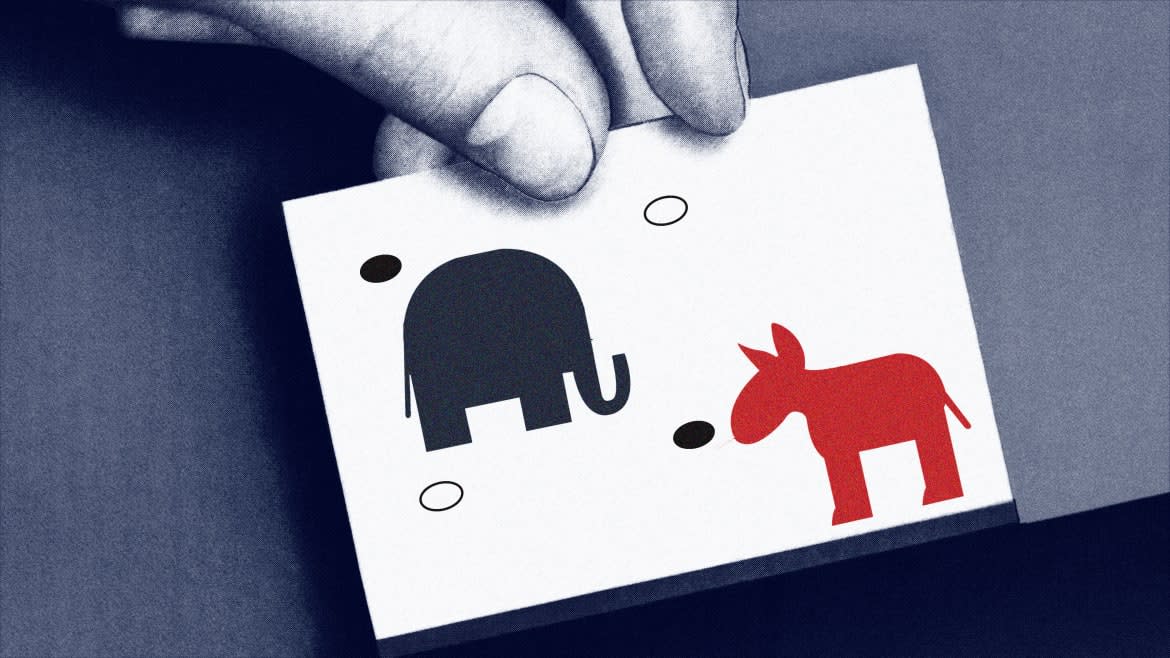How Ticket-Splitting ‘Vibes’ Voters Blocked the Red Wave

Like ’80s movie reboots and low-rise jeans, split-ticket voters made quite a comeback in 2022.
It wasn’t exactly a nationwide phenomenon, but the ingredients were largely the same in states where enough people voted for two different parties in Senate and gubernatorial races that it made a difference, or at least put a big enough dent in a MAGA candidate’s margin of victory.
Even in states where the same party won statewide for governorships and Senate seats, there were significant drop-offs in vote totals between MAGA-aligned Republicans and more popular moderates, the result of voters either backing two different parties in separate races—the traditional definition of split-ticket voting—or leaving one of the slots blank.
The clearest examples were New Hampshire, Ohio, and Pennsylvania. Nevada, Wisconsin, and the Granite State delivered mixed verdicts with the two parties splitting gubernatorial and Senate races. Georgia would also fall into that category if Sen. Raphael Warnock wins the December runoff.
Arizona proved to be a notable exception, but there was still some discernible split-ticket voting in Sen.-elect Mark Kelly’s coalition, with the Democrat and former astronaut picking up some crossover support against his Republican opponent, Blake Masters, who underperformed GOP gubernatorial nominee Kari Lake by 3 points, a little more than 73,000 votes with 95 percent of returns in.
Each state had its own quirks, but for all the exit poll data and voter registration trends available to help explain why split-ticket voting suddenly became a thing again in some pockets of the country, an Ohio political scientist boiled it down to what one might call “vibes” voters.
“I don’t know how sophisticated the average voter is in making these kinds of decisions,” David Cohen, a professor at the University of Akron, told The Daily Beast. “It comes down to vibes. Voters can sense if a Republican candidate is more of a moderate type—like a Larry Hogan in Maryland, for example—or if that candidate is beholden to Donald Trump and the MAGA wing.”
How Abortion Saved Democrats at the State Level
Although both Republican candidates won in Ohio’s senate and governor’s race, Gov. Mike DeWine outperformed Sen.-elect J.D. Vance by almost 10 points. At the Ohio GOP’s “victory party” in downtown Columbus, an awkward few hours ensued between an early call for DeWine and Vance’s eventual victory speech closer to midnight.
Cohen attributed Rep. Tim Ryan’s loss in the Senate race to lower turnout in the metro areas of Cleveland and Columbus, but added that Ohio may simply be “following the path of Missouri from swing state to red state.”
“You can sense in the country there’s some backlash to the MAGA,” Cohen said.
In Pennsylvania, Gov.-elect Josh Shapiro walloped GOP state senator and ardent election denier Doug Mastriano by 15 points, while the Senate race came down to a less than 5 point margin for Democrat John Fetterman over Republican Mehmet Oz.
Both Mastriano and Oz had Trump’s endorsement, but they rarely campaigned together or coordinated like Shapiro and Fetterman.
In another notable example of where candidate quality comes into play—a TV doctor with sky high name ID versus a conspiracy theory embracing state lawmaker who froze out all but a few right-wing outlets with unidentified “security” guards at his events. That dynamic made it clear it t was more than just the association with Trump contributing to the disparity in Pennsylvania, veteran pollster Terry Madonna explained.
“Yes, he was a big Trumpite and Trump endorsed him and he followed Trump on the stolen election, but he also had other extreme positions,” Madonna, a senior fellow at Millersville University and former director of the Franklin & Marshall College Poll, said of Mastriano.
Mastriano ran on abortion restrictions with no exemptions for rape or incest and also embraced Dominionism, a belief that God has ordained Republicans with the legitimacy to rule in preparation for the Second Coming of Christ.
“A dozen former Republican state lawmakers formally endorsed Shapiro, and the establishment just simply moved away from him because of his extreme far right positions on a whole variety of things.” Madonna said.
Although the Trump factor was inextricable from several of these battleground Senate races in states that also had a governor’s seat up for grabs, some of the same hallmarks from old school split-ticket voting still emerged.
John Fetterman Sends Dr. Oz Packing Back to New Jersey
Dante Scala, a University of New Hampshire political science professor, compared to the popularity of Republican Gov. Chris Sununu in his landslide reelection victory to former Democratic Gov. John Lynch in the late aughts.
Sununu won his race by 16 points while Democratic Sen. Maggie Hassan beat her Trump-aligned GOP challenger by 9 points.
As subjective as the notion of candidate quality can be, the scope of a campaign’s strategy and to what extent they’re even trying to persuade voters can explain what makes a few hundred thousand Americans more willing to give each party a shot, depending on the vibe.
Madonna framed the split-ticket phenomenon across battleground states as a basic understanding of coalitions in a two-party system.
“The big point here is you have this candidate who has wide appeal, and another with little more than negative appeal.”
Get the Daily Beast's biggest scoops and scandals delivered right to your inbox. Sign up now.
Stay informed and gain unlimited access to the Daily Beast's unmatched reporting. Subscribe now.


